Thursday, 22 July 2010: Tournai to Dinant, at snail's pace
Written 31 July 2010
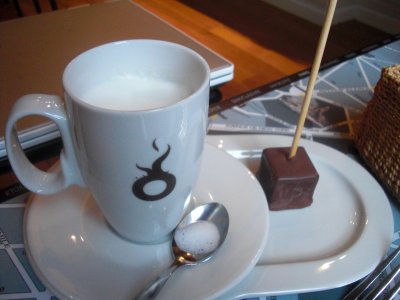 We were sorry to leave the Hotel d'Alcantara—comfortable, friendly (family run), and altogether satisfactory. Their breakfast hot chocolate was unique in my experience (although David says he's encountered it before in Paris). They bring you a cup of hot milk (in a special cup with the brand's logo on it), together with a solid cube of soft chocolate on a stick, which you dip into the milk and stir until enough chocolate has melted into the milk to suit you (I used all of it). Excellent.
We were sorry to leave the Hotel d'Alcantara—comfortable, friendly (family run), and altogether satisfactory. Their breakfast hot chocolate was unique in my experience (although David says he's encountered it before in Paris). They bring you a cup of hot milk (in a special cup with the brand's logo on it), together with a solid cube of soft chocolate on a stick, which you dip into the milk and stir until enough chocolate has melted into the milk to suit you (I used all of it). Excellent.
Christine Jackson and I overlapped at breakfast again, and this time David came down early enough to meet her as well (we were anxious to move our car before parking enforcement began for the day, and we had a long drive ahead of us0.
We managed to get all the way from Tournai to Dinant without once straying into some other country, though we passed some pretty American/International stuff, like the U.S. Army Chièvre Garrison and S.H.A.P.E. (Supreme Headquarters Allied Powers Europe). Shortly thereafter, we pulled over at a likely-looking little country restaurant called "La Clairière," i.e., "the clearing," which was, in fact located in an open area surrounded by forest. It turned out to be a good choice; we had a lovely lunch.
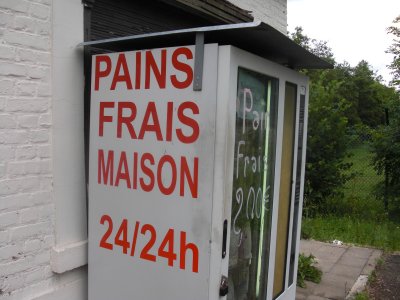
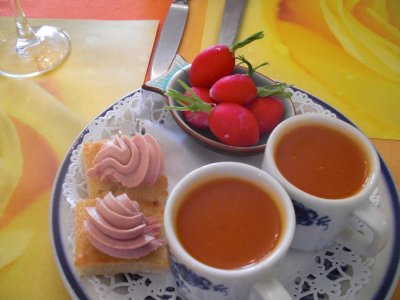 The restaurant bakes all its own bread, and outside, off to one side of the entrance, was this ramshackle but apparently functional vending machine, hand-lettered "fresh homemade bread," where you could buy their baguettes day or night. Above it a little sign said, "Smile, you are being videotaped."
The restaurant bakes all its own bread, and outside, off to one side of the entrance, was this ramshackle but apparently functional vending machine, hand-lettered "fresh homemade bread," where you could buy their baguettes day or night. Above it a little sign said, "Smile, you are being videotaped."
While we waited for our lunch, we were served an amuse bouche of little cups of gazpacho, rosettes of liver pâté (pork, I think); on toast squares, and fresh radishes.
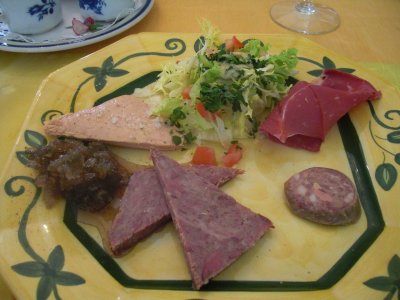
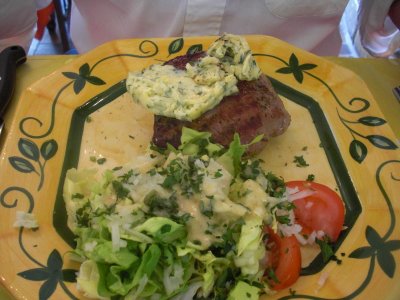 I ordered the "assiette du Périgord," the plate of products from the Périgord region (inland from Bordeaux), which included duck-liver pâté, duck ham, rillettes of duck, and sausage formed in a goose's neck skin, accompanied by a (slightly crystalized) jam of onions and fennel and, on the side, a plate of raisin toast. Delicious!
I ordered the "assiette du Périgord," the plate of products from the Périgord region (inland from Bordeaux), which included duck-liver pâté, duck ham, rillettes of duck, and sausage formed in a goose's neck skin, accompanied by a (slightly crystalized) jam of onions and fennel and, on the side, a plate of raisin toast. Delicious!
David actually ordered "steak frites," an "aloyau" (sirloin?) of beef with a great slab of parlsey-shallot butter on top, with salad and a separate plate of excellent french fries. Wish we had that place for our neighborhood restaurant!
My goal for the day, though, was to visit a snail farm, an "escargotière." Snail farming is called "héliculture. The place I had scoped out on the web as seeming the most propitious (of four that were near our itinerary) was the Escargotière de Warnant, a few miles northwest of Dinant, so we stopped there before exploring Dinant itself, and it turned out to be a good choice. We had to wait around for a few minutes for the next scheduled tour, so we had lots of time to peruse the snail-based products offered for sale, as well as the other regional products they offered (hibiscus beer, honey and honey candies, snail-themed crockery. And snail caviare—snail eggs (at least of the variety raised at Warnant) are white and about the size of salmon caviare; they clean them, salt them, and pack them in jars.
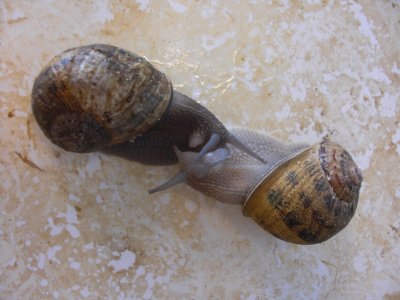
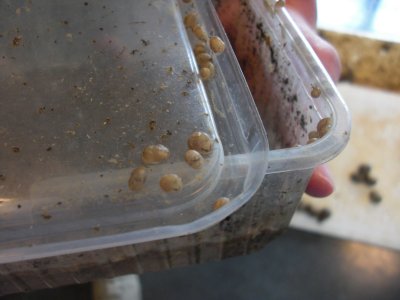 The tour started indoors, where young François, our guide, began with a slide show and then showed us a bunch of snails assembled for the purpose. As the photo at the left shows, as soon as they were taken out of the cooler and warmed up a little, they started to take an interest in each other (snails are hermaphrodites but cannot self-fertilize, so mating is a mutual affair). The snails raised at Warnant (and in most other such operations) are "petits gris" (little greys, Helix aspersa), as opposed to the larger escargot de Bourgogne (Helix pomatia), which isn't as tolerant of crowding. They are raised as annuals, and the escargotière goes through one rearing cycle per year. You can tell when a petit gris reaches sexual maturity, because the edge of its shell develops the little upturned rim visible in the photo. As they mature, they are collected, encouraged to mate, allow to lay their eggs (in special chambers that makes recovery of the eggs easy), and then sent off to the kitchens for preparation. The growers select a little for size, but otherwise, most of each years population serves as breeders for the next. For the tours, they keep a few escargots de Bourgogne around, so as to demonstrate how to tell the two species apart. In comparison to the others, petits gris are a little smaller, their shells not so perfectly round (a little elongated anterior to posterior), and their mantles, where they attach to the shell, are light grey rather than the much darker color of the Bourgognes.
The tour started indoors, where young François, our guide, began with a slide show and then showed us a bunch of snails assembled for the purpose. As the photo at the left shows, as soon as they were taken out of the cooler and warmed up a little, they started to take an interest in each other (snails are hermaphrodites but cannot self-fertilize, so mating is a mutual affair). The snails raised at Warnant (and in most other such operations) are "petits gris" (little greys, Helix aspersa), as opposed to the larger escargot de Bourgogne (Helix pomatia), which isn't as tolerant of crowding. They are raised as annuals, and the escargotière goes through one rearing cycle per year. You can tell when a petit gris reaches sexual maturity, because the edge of its shell develops the little upturned rim visible in the photo. As they mature, they are collected, encouraged to mate, allow to lay their eggs (in special chambers that makes recovery of the eggs easy), and then sent off to the kitchens for preparation. The growers select a little for size, but otherwise, most of each years population serves as breeders for the next. For the tours, they keep a few escargots de Bourgogne around, so as to demonstrate how to tell the two species apart. In comparison to the others, petits gris are a little smaller, their shells not so perfectly round (a little elongated anterior to posterior), and their mantles, where they attach to the shell, are light grey rather than the much darker color of the Bourgognes.
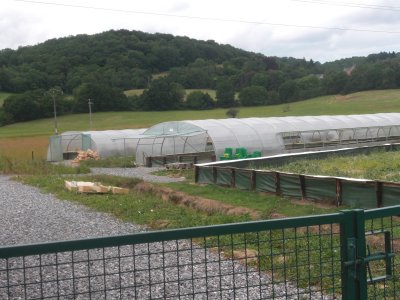
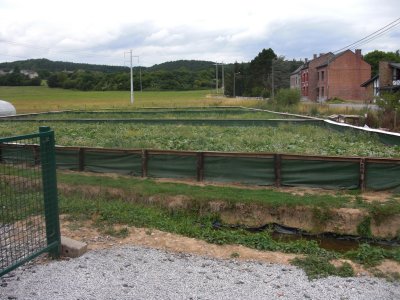 The hatchlings, called "naissants" (newborns; shown on the edges of the plastic tub at the right) are then transferred each spring to the sheds shown at the left. The sides are open, but the fiberglass canopies provide shade and some shelter from the elements. There, the little snails eat and grow until they're big enough to be transferred to the "parks," of which the Warnant operation has three, all visible in the photo at the right, one behind the other. Each park is planted with cabbage and colza (i.e., oil-seed rape) and is surrounded by a low wall with a plywood overhang. The underside of the overhang is smeared with a mixture of grease and "black soap," which snails hate, to keep the snails from climbing out. Each park harbors something like 300,000 snails, but only ca. 200,000 are harvested, as a result of losses to predators, disease, etc.
The hatchlings, called "naissants" (newborns; shown on the edges of the plastic tub at the right) are then transferred each spring to the sheds shown at the left. The sides are open, but the fiberglass canopies provide shade and some shelter from the elements. There, the little snails eat and grow until they're big enough to be transferred to the "parks," of which the Warnant operation has three, all visible in the photo at the right, one behind the other. Each park is planted with cabbage and colza (i.e., oil-seed rape) and is surrounded by a low wall with a plywood overhang. The underside of the overhang is smeared with a mixture of grease and "black soap," which snails hate, to keep the snails from climbing out. Each park harbors something like 300,000 snails, but only ca. 200,000 are harvested, as a result of losses to predators, disease, etc.
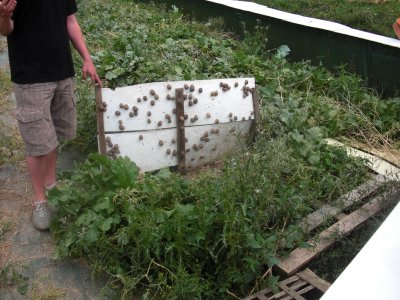
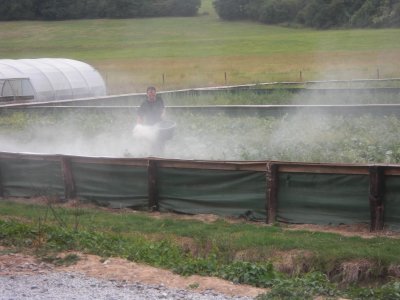 Strewn haphazarly around the parks and covering a third to half their area are sheets of old plywood, upturned wooden crates, and whatnot—anything under which the snails, which feed at night, can hide during the day for protection from the sun and predatory birds. In the left-hand photo, François has lifted one of the pieces of wood to show us the snails hiding underneath. The plants in the parks are all dusty with a mixture of corn and wheat flours and powdered calcium (which the snails need for shell-building) that the snail farmers add as a dietary supplement (during the depuration process, they're fed only the flour mixture). The right-hand photo shows another employee throwing big handfuls of fresh flour mixture around the park we had just visited.
Strewn haphazarly around the parks and covering a third to half their area are sheets of old plywood, upturned wooden crates, and whatnot—anything under which the snails, which feed at night, can hide during the day for protection from the sun and predatory birds. In the left-hand photo, François has lifted one of the pieces of wood to show us the snails hiding underneath. The plants in the parks are all dusty with a mixture of corn and wheat flours and powdered calcium (which the snails need for shell-building) that the snail farmers add as a dietary supplement (during the depuration process, they're fed only the flour mixture). The right-hand photo shows another employee throwing big handfuls of fresh flour mixture around the park we had just visited.
The avian predators of snails are mainly the larger corvids (crows, ravens, magpies, jays), and though François didn't mention them, I suspect herons would not be averse to the occasional snail. In the wild, a major snail predator is the hedgehog (I had never thought about it before, but yeah, what can a predator with the speed and agility of a hedgehog catch?), but they neither climb nor burrow and are therefore effectively excluded by the park walls. The predators that cause the most damage to snail farms are rats, so the farm has one of those white Scottish terriers, who takes his job very seriously. The breed was developed as ratters, and he's apparently really good at it. François says he patrols the perimeter of the parks and sheds several times a day, checking for rat spoor and leaving his scent, which is a good rat deterrent. If a rat or other predator actually gets into one of the parks, they just lift the dog over the fence, and he promptly sniffs it out, runs it to ground, digs it out, and kills it.
That's the whole rearing operation—no pesticides, no medications (apparently, snail veterinary medicine is in its infancy, and nobody knows how to treat snail diseases other than to destroy the affected snails; I saw a few cabbage looper butterflies, but not a lot; maybe the flour dusting discourages them). One of the other visitors therefore asked whether the Warnant snails are certified organic. No, apparently they aren't, but only because the EU regulators are still arguing over how to classify them—as seafood? as meat?—and therefore can't decide what regulations they should fall under.
Once the snails reach maturity (or the end of the growing season, whichever comes first), they're collected by hand, brought inside, and kept in cold rooms. The breeders are bred and allowed to lay eggs. Then, after depuration, they're processed—they're blanched for a couple of minutes in boiling water, cooled, and extracted (one by one, by hand, with a little two-tined fork) from their shells. The shells are boiled, rinsed, and set aside to dry. The snails are washed and rinsed in hot water and then cooked in court-bouillon (a seasoned broth mixture) for 1 to 1.25 hours, until tender. At that point, they're either sold plain by the pound to restaurants or individuals, prepared in any of several ways and sold that way, or frozen for later processing (the staff can't prepare the whole crop for sale at once, so they thaw them in batches for preparation later). The "standard" preparation is to replace each snail in its shell (well, in one of the shells, probably actually someone else's) and to pack it in with a good glob of garlic-and-parsley butter. The shop sells foil trays of them, which you take home and heat in the oven until sizzling hot. In addition, the Warnant kitches prepare them the same way but with a spicy red butter. Other preparations are a couple of different snail stews, sold in jars; a snail pâté for spreading on bread or crackers; the snail caviare of course; and the one we got to taste—snail profiteroles. They make a whole raft of miniature cream puffs and fill each one with a snail (no shell) and the garlic butter mixture. The whole assembly, puff and all, is then heated in the oven, and the result is heavenly; probably the best snail I've ever eaten; crispy, buttery, garlicky, tender, and delicious!
Finally, François warned us solemnly to read the fine print. He claims that up to 90% if the "escargots de Bourgogne" sold in Belgium are actually chunks of the flesh of an Asian gastropod (Achatina sp.) that can grow up to a kilogram in size and is tough and indigestible, but by law, the label or menu must say, somewhere in the fine print, "chair d'achatine," ("achatine flesh"). I personally don't recall ever being served a snail that I could not see to be entirely snail-shaped (and not a chunk of something else), but then I don't think I'd ever before eaten snails in Belgium. Perhaps the snail soup for sale on the streets of Ghent during the festival were actually "chair d'achatine." I can't see the French holding still for that kind of thing, but I'll look into it. The Warnant snails were certainly not tough, or even chewy, and I didn't find them indigestible (but, as David points out, I find very little to be indigestible).
Written 1 August 2010
After the tour, we drove the short distance into Dinant, which lines both sides of the Meuse river, where it passes through a narrow declivity between high cliffs. As a result, the tourist map of the town unfolds accordionwise and is about 8 inches by 3 feet. We stayed at the Ibis, which was easy to find, as the town is so narrow—it was right on the river, so we had a great view. On the reception desk was a notice that the power would be out between 5 and 6 a.m. the following morning, for repairs to high-tension lines damaged by the storm of 14 July (the same one that rained on us in Bruges and stopped the trains in Brussels). It was too late in the day for any major tours or museum visits, but we walked around and scoped out the possibilities.
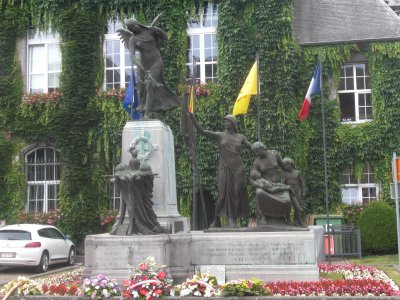
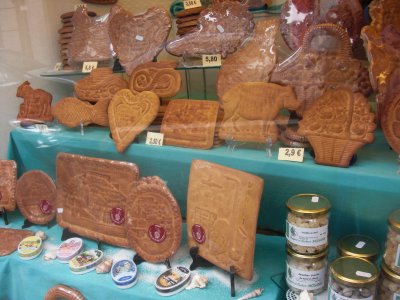 In the courtyard of the town hall was this monument dedicated to both the WWI soldiers from Dinant and the WWII deportees from the town. In many show windows were these large, durable cookies, called "couques" (pronounced "kook"; the word may even be cognate with "cookie"). They are made of "Dinant gingerbread," traditionally consisting only of honey and flour, and they are proudly proclaimed to be the hardest cookie in the world. The rather quaint English translation in one window concluded, ". . . and they are shipped all over the world, for example to the USA, where they are used as ornamental cookies." I assume that locally they are also, at least sometimes, eaten. The jars are filled with honey-flavored hard candy.
In the courtyard of the town hall was this monument dedicated to both the WWI soldiers from Dinant and the WWII deportees from the town. In many show windows were these large, durable cookies, called "couques" (pronounced "kook"; the word may even be cognate with "cookie"). They are made of "Dinant gingerbread," traditionally consisting only of honey and flour, and they are proudly proclaimed to be the hardest cookie in the world. The rather quaint English translation in one window concluded, ". . . and they are shipped all over the world, for example to the USA, where they are used as ornamental cookies." I assume that locally they are also, at least sometimes, eaten. The jars are filled with honey-flavored hard candy.
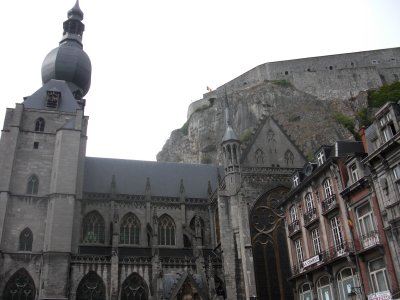
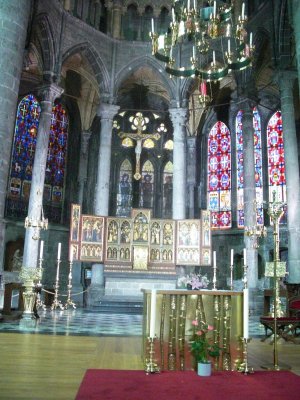 Dinant has many claims to fame, addition to the couques. Number one on our list was the imposing citadel that dominates the town from the top of the cliffs on the eastern side, visible here above the rooftops of some town buildings and the main church (the Collegiale Notre Dame, with the tower). We put off the citadel until the following morning but took a few minutes to look inside the church. The church is notable for having originally been built in the romanesque style, then rebuilt in gothic style after a large section of the cliff fell off one night and crushed three quarters of it.
Dinant has many claims to fame, addition to the couques. Number one on our list was the imposing citadel that dominates the town from the top of the cliffs on the eastern side, visible here above the rooftops of some town buildings and the main church (the Collegiale Notre Dame, with the tower). We put off the citadel until the following morning but took a few minutes to look inside the church. The church is notable for having originally been built in the romanesque style, then rebuilt in gothic style after a large section of the cliff fell off one night and crushed three quarters of it.
In fact, Dinant has way too many claims to fame, most of which we had to skip. (Everywhere we went on this trip, I estimate that, if we spent twice the time in each place, we could have at least set foot in all the top attractions—the lesser ones, like the museum of wool the the birthplaces of painters, would have taken as much time again.) For example, it is famous for metalwork in a "silvery brass alloy" called (for the town) dinanderie; no time for the museum, which was featuring both modern and 500-year-old examples. It is also the home of the "Maison de Pataphonie," which so far as I can tell is a center for the promotion of creative use of almost anything as a percussion instrument; no time for that either. Neither last nor least, it is the birthplace of Adolphe Sax (1814-1894), famous inventor of musical instruments, whose greatest success was the saxophone. Saxophone imagery was everywhere (on the signs for businesses, as a shape for candies and breads, in the ornamental lights hung above the streets, in the sidewalk grills around the street trees). Sax's house is a museum (no time for that) and is currently being expanded and renovated in preparation for "L'Europe mise au saxe" ("Europe put to the sax," a pun on "Europe put to the sack," i.e., ravaged and looted), a huge saxophone festival and convention, which is scheduled for 13 November 2010. The last one was about nine years ago, I think. We didn't even have time for the boat tours on the river or the local tourist-attraction caverne.
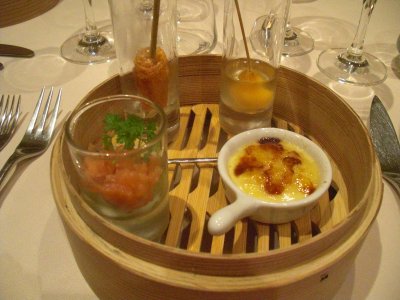
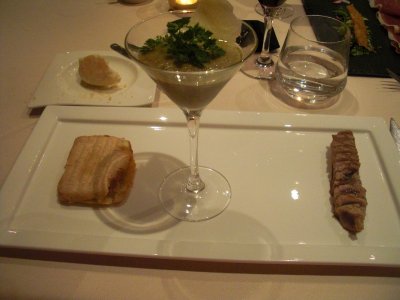 Dinner was at "La Broche" (the roasting-spit), where the amuse bouche was four-fold, clockwise from upper left: a tiny eggroll on a stick, a melon ball on a stick in a glass of sweet wine (David gave me his melon ball, and neither of us cared for the wine), a miniature foie-gras crême brulée, and a glass of tuna tartare. All four were served in a bamboo steamer tray. My first course was billed as seared tuna (the row of slices at the right), but the standout was the martini glass full of cold seasoned eggplant purée. On the left was a miniature panini of mozzarella and confit tomato. Yummy.
Dinner was at "La Broche" (the roasting-spit), where the amuse bouche was four-fold, clockwise from upper left: a tiny eggroll on a stick, a melon ball on a stick in a glass of sweet wine (David gave me his melon ball, and neither of us cared for the wine), a miniature foie-gras crême brulée, and a glass of tuna tartare. All four were served in a bamboo steamer tray. My first course was billed as seared tuna (the row of slices at the right), but the standout was the martini glass full of cold seasoned eggplant purée. On the left was a miniature panini of mozzarella and confit tomato. Yummy.
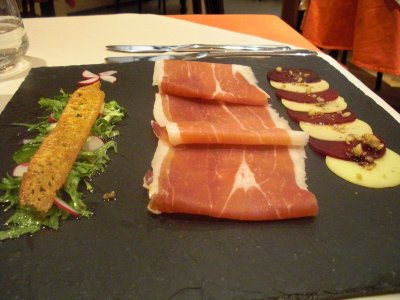
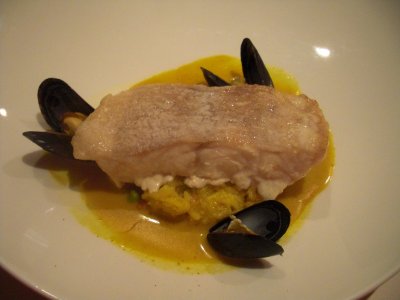 David's starter was Parma ham with carpaccio of cheese and beets, garnished with a small salad, elongated crouton, and cute radish pinwheel. My main course was "fish of the moment" (cod, I think) steamed on a bed of paella and garlished with saffron sauce and three mussels in the shell. David's main course was special chicken from the southwest of France with a sauce of orange and foie gras, accompanied by mashed potatoes—all white-on-cream-on-beige colored but very tasty.
David's starter was Parma ham with carpaccio of cheese and beets, garnished with a small salad, elongated crouton, and cute radish pinwheel. My main course was "fish of the moment" (cod, I think) steamed on a bed of paella and garlished with saffron sauce and three mussels in the shell. David's main course was special chicken from the southwest of France with a sauce of orange and foie gras, accompanied by mashed potatoes—all white-on-cream-on-beige colored but very tasty.
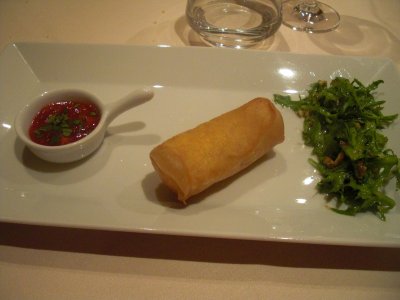
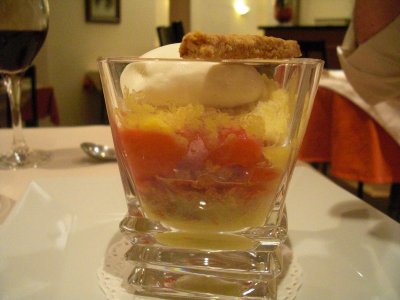 With the menu we ordered, we got the choice between a cheese course and the evening's special plum dessert, so we got one of each. The cheese course turned out to be a small log of goat's cheese wrapped in a feuille de brik and either baked or fried until crispy—sort of a tender cheese eggroll—and accompanied by chilled fresh stewed strawberries and a small salad. Excellent—I've got to try that at home. The dessert was stewed plums layered with shortbread crumbs and excellent fromage-blanc ice cream. If you'd told us it was rhubarb, we'd have believed it. Very good.
With the menu we ordered, we got the choice between a cheese course and the evening's special plum dessert, so we got one of each. The cheese course turned out to be a small log of goat's cheese wrapped in a feuille de brik and either baked or fried until crispy—sort of a tender cheese eggroll—and accompanied by chilled fresh stewed strawberries and a small salad. Excellent—I've got to try that at home. The dessert was stewed plums layered with shortbread crumbs and excellent fromage-blanc ice cream. If you'd told us it was rhubarb, we'd have believed it. Very good.
previous entry
List of Entries
next entry
 We were sorry to leave the Hotel d'Alcantara—comfortable, friendly (family run), and altogether satisfactory. Their breakfast hot chocolate was unique in my experience (although David says he's encountered it before in Paris). They bring you a cup of hot milk (in a special cup with the brand's logo on it), together with a solid cube of soft chocolate on a stick, which you dip into the milk and stir until enough chocolate has melted into the milk to suit you (I used all of it). Excellent.
We were sorry to leave the Hotel d'Alcantara—comfortable, friendly (family run), and altogether satisfactory. Their breakfast hot chocolate was unique in my experience (although David says he's encountered it before in Paris). They bring you a cup of hot milk (in a special cup with the brand's logo on it), together with a solid cube of soft chocolate on a stick, which you dip into the milk and stir until enough chocolate has melted into the milk to suit you (I used all of it). Excellent.
 The restaurant bakes all its own bread, and outside, off to one side of the entrance, was this ramshackle but apparently functional vending machine, hand-lettered "fresh homemade bread," where you could buy their baguettes day or night. Above it a little sign said, "Smile, you are being videotaped."
The restaurant bakes all its own bread, and outside, off to one side of the entrance, was this ramshackle but apparently functional vending machine, hand-lettered "fresh homemade bread," where you could buy their baguettes day or night. Above it a little sign said, "Smile, you are being videotaped."
 I ordered the "assiette du Périgord," the plate of products from the Périgord region (inland from Bordeaux), which included duck-liver pâté, duck ham, rillettes of duck, and sausage formed in a goose's neck skin, accompanied by a (slightly crystalized) jam of onions and fennel and, on the side, a plate of raisin toast. Delicious!
I ordered the "assiette du Périgord," the plate of products from the Périgord region (inland from Bordeaux), which included duck-liver pâté, duck ham, rillettes of duck, and sausage formed in a goose's neck skin, accompanied by a (slightly crystalized) jam of onions and fennel and, on the side, a plate of raisin toast. Delicious!
 The tour started indoors, where young François, our guide, began with a slide show and then showed us a bunch of snails assembled for the purpose. As the photo at the left shows, as soon as they were taken out of the cooler and warmed up a little, they started to take an interest in each other (snails are hermaphrodites but cannot self-fertilize, so mating is a mutual affair). The snails raised at Warnant (and in most other such operations) are "petits gris" (little greys, Helix aspersa), as opposed to the larger escargot de Bourgogne (Helix pomatia), which isn't as tolerant of crowding. They are raised as annuals, and the escargotière goes through one rearing cycle per year. You can tell when a petit gris reaches sexual maturity, because the edge of its shell develops the little upturned rim visible in the photo. As they mature, they are collected, encouraged to mate, allow to lay their eggs (in special chambers that makes recovery of the eggs easy), and then sent off to the kitchens for preparation. The growers select a little for size, but otherwise, most of each years population serves as breeders for the next. For the tours, they keep a few escargots de Bourgogne around, so as to demonstrate how to tell the two species apart. In comparison to the others, petits gris are a little smaller, their shells not so perfectly round (a little elongated anterior to posterior), and their mantles, where they attach to the shell, are light grey rather than the much darker color of the Bourgognes.
The tour started indoors, where young François, our guide, began with a slide show and then showed us a bunch of snails assembled for the purpose. As the photo at the left shows, as soon as they were taken out of the cooler and warmed up a little, they started to take an interest in each other (snails are hermaphrodites but cannot self-fertilize, so mating is a mutual affair). The snails raised at Warnant (and in most other such operations) are "petits gris" (little greys, Helix aspersa), as opposed to the larger escargot de Bourgogne (Helix pomatia), which isn't as tolerant of crowding. They are raised as annuals, and the escargotière goes through one rearing cycle per year. You can tell when a petit gris reaches sexual maturity, because the edge of its shell develops the little upturned rim visible in the photo. As they mature, they are collected, encouraged to mate, allow to lay their eggs (in special chambers that makes recovery of the eggs easy), and then sent off to the kitchens for preparation. The growers select a little for size, but otherwise, most of each years population serves as breeders for the next. For the tours, they keep a few escargots de Bourgogne around, so as to demonstrate how to tell the two species apart. In comparison to the others, petits gris are a little smaller, their shells not so perfectly round (a little elongated anterior to posterior), and their mantles, where they attach to the shell, are light grey rather than the much darker color of the Bourgognes.
 The hatchlings, called "naissants" (newborns; shown on the edges of the plastic tub at the right) are then transferred each spring to the sheds shown at the left. The sides are open, but the fiberglass canopies provide shade and some shelter from the elements. There, the little snails eat and grow until they're big enough to be transferred to the "parks," of which the Warnant operation has three, all visible in the photo at the right, one behind the other. Each park is planted with cabbage and colza (i.e., oil-seed rape) and is surrounded by a low wall with a plywood overhang. The underside of the overhang is smeared with a mixture of grease and "black soap," which snails hate, to keep the snails from climbing out. Each park harbors something like 300,000 snails, but only ca. 200,000 are harvested, as a result of losses to predators, disease, etc.
The hatchlings, called "naissants" (newborns; shown on the edges of the plastic tub at the right) are then transferred each spring to the sheds shown at the left. The sides are open, but the fiberglass canopies provide shade and some shelter from the elements. There, the little snails eat and grow until they're big enough to be transferred to the "parks," of which the Warnant operation has three, all visible in the photo at the right, one behind the other. Each park is planted with cabbage and colza (i.e., oil-seed rape) and is surrounded by a low wall with a plywood overhang. The underside of the overhang is smeared with a mixture of grease and "black soap," which snails hate, to keep the snails from climbing out. Each park harbors something like 300,000 snails, but only ca. 200,000 are harvested, as a result of losses to predators, disease, etc.
 Strewn haphazarly around the parks and covering a third to half their area are sheets of old plywood, upturned wooden crates, and whatnot—anything under which the snails, which feed at night, can hide during the day for protection from the sun and predatory birds. In the left-hand photo, François has lifted one of the pieces of wood to show us the snails hiding underneath. The plants in the parks are all dusty with a mixture of corn and wheat flours and powdered calcium (which the snails need for shell-building) that the snail farmers add as a dietary supplement (during the depuration process, they're fed only the flour mixture). The right-hand photo shows another employee throwing big handfuls of fresh flour mixture around the park we had just visited.
Strewn haphazarly around the parks and covering a third to half their area are sheets of old plywood, upturned wooden crates, and whatnot—anything under which the snails, which feed at night, can hide during the day for protection from the sun and predatory birds. In the left-hand photo, François has lifted one of the pieces of wood to show us the snails hiding underneath. The plants in the parks are all dusty with a mixture of corn and wheat flours and powdered calcium (which the snails need for shell-building) that the snail farmers add as a dietary supplement (during the depuration process, they're fed only the flour mixture). The right-hand photo shows another employee throwing big handfuls of fresh flour mixture around the park we had just visited.
 In the courtyard of the town hall was this monument dedicated to both the WWI soldiers from Dinant and the WWII deportees from the town. In many show windows were these large, durable cookies, called "couques" (pronounced "kook"; the word may even be cognate with "cookie"). They are made of "Dinant gingerbread," traditionally consisting only of honey and flour, and they are proudly proclaimed to be the hardest cookie in the world. The rather quaint English translation in one window concluded, ". . . and they are shipped all over the world, for example to the USA, where they are used as ornamental cookies." I assume that locally they are also, at least sometimes, eaten. The jars are filled with honey-flavored hard candy.
In the courtyard of the town hall was this monument dedicated to both the WWI soldiers from Dinant and the WWII deportees from the town. In many show windows were these large, durable cookies, called "couques" (pronounced "kook"; the word may even be cognate with "cookie"). They are made of "Dinant gingerbread," traditionally consisting only of honey and flour, and they are proudly proclaimed to be the hardest cookie in the world. The rather quaint English translation in one window concluded, ". . . and they are shipped all over the world, for example to the USA, where they are used as ornamental cookies." I assume that locally they are also, at least sometimes, eaten. The jars are filled with honey-flavored hard candy.
 Dinant has many claims to fame, addition to the couques. Number one on our list was the imposing citadel that dominates the town from the top of the cliffs on the eastern side, visible here above the rooftops of some town buildings and the main church (the Collegiale Notre Dame, with the tower). We put off the citadel until the following morning but took a few minutes to look inside the church. The church is notable for having originally been built in the romanesque style, then rebuilt in gothic style after a large section of the cliff fell off one night and crushed three quarters of it.
Dinant has many claims to fame, addition to the couques. Number one on our list was the imposing citadel that dominates the town from the top of the cliffs on the eastern side, visible here above the rooftops of some town buildings and the main church (the Collegiale Notre Dame, with the tower). We put off the citadel until the following morning but took a few minutes to look inside the church. The church is notable for having originally been built in the romanesque style, then rebuilt in gothic style after a large section of the cliff fell off one night and crushed three quarters of it.
 Dinner was at "La Broche" (the roasting-spit), where the amuse bouche was four-fold, clockwise from upper left: a tiny eggroll on a stick, a melon ball on a stick in a glass of sweet wine (David gave me his melon ball, and neither of us cared for the wine), a miniature foie-gras crême brulée, and a glass of tuna tartare. All four were served in a bamboo steamer tray. My first course was billed as seared tuna (the row of slices at the right), but the standout was the martini glass full of cold seasoned eggplant purée. On the left was a miniature panini of mozzarella and confit tomato. Yummy.
Dinner was at "La Broche" (the roasting-spit), where the amuse bouche was four-fold, clockwise from upper left: a tiny eggroll on a stick, a melon ball on a stick in a glass of sweet wine (David gave me his melon ball, and neither of us cared for the wine), a miniature foie-gras crême brulée, and a glass of tuna tartare. All four were served in a bamboo steamer tray. My first course was billed as seared tuna (the row of slices at the right), but the standout was the martini glass full of cold seasoned eggplant purée. On the left was a miniature panini of mozzarella and confit tomato. Yummy.
 David's starter was Parma ham with carpaccio of cheese and beets, garnished with a small salad, elongated crouton, and cute radish pinwheel. My main course was "fish of the moment" (cod, I think) steamed on a bed of paella and garlished with saffron sauce and three mussels in the shell. David's main course was special chicken from the southwest of France with a sauce of orange and foie gras, accompanied by mashed potatoes—all white-on-cream-on-beige colored but very tasty.
David's starter was Parma ham with carpaccio of cheese and beets, garnished with a small salad, elongated crouton, and cute radish pinwheel. My main course was "fish of the moment" (cod, I think) steamed on a bed of paella and garlished with saffron sauce and three mussels in the shell. David's main course was special chicken from the southwest of France with a sauce of orange and foie gras, accompanied by mashed potatoes—all white-on-cream-on-beige colored but very tasty.
 With the menu we ordered, we got the choice between a cheese course and the evening's special plum dessert, so we got one of each. The cheese course turned out to be a small log of goat's cheese wrapped in a feuille de brik and either baked or fried until crispy—sort of a tender cheese eggroll—and accompanied by chilled fresh stewed strawberries and a small salad. Excellent—I've got to try that at home. The dessert was stewed plums layered with shortbread crumbs and excellent fromage-blanc ice cream. If you'd told us it was rhubarb, we'd have believed it. Very good.
With the menu we ordered, we got the choice between a cheese course and the evening's special plum dessert, so we got one of each. The cheese course turned out to be a small log of goat's cheese wrapped in a feuille de brik and either baked or fried until crispy—sort of a tender cheese eggroll—and accompanied by chilled fresh stewed strawberries and a small salad. Excellent—I've got to try that at home. The dessert was stewed plums layered with shortbread crumbs and excellent fromage-blanc ice cream. If you'd told us it was rhubarb, we'd have believed it. Very good.